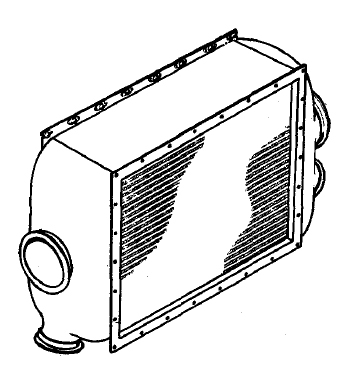
Heat exchangers are used in aircraft of all sizes, flying different missions, in many different aircraft systems. Sometimes a heat exchanger is used to cool something, such as the air in the cabin; sometimes to warm something, such as the fuel in the tanks. Their theory of operation is simple, yet they are vital to the performance of the aircraft.
A heat exchanger contains two separate flow paths. The two do not come in contact with each other; only the heat energy within the unit is exchanged. A heat exchanger core contains no moving parts, although, depending on the application, there could be a valve to restrict or increase flow to change the amount of heating or cooling. The radiator in your car is a heat exchanger--airflow through it cools the engine coolant circulating inside.
Heat exchangers are nearly ubiquitous in large transport aircraft. Many major systems use them. Hydraulic systems cool their fluid, and warm the fuel, with heat exchangers placed inside fuel tanks. Cabin pressurization systems cool the hot engine bleed air to a temperature suitable for use within the cabin with a heat exchanger. The air conditioning system is based on a heat exchanger, known as an air-cycle machine, to provide air at the desired temperature to the cabin and flight deck.
Smaller aircraft don't have the complexity of their larger cousins, but they still utilize heat exchangers for different reasons. Nearly all have an oil cooler, which is simply a heat exchanger that allows air to flow over a coil (radiator) carrying hot engine oil. Some larger piston-engine aircraft use a combustion heater for cabin heat. In this unit, a burner provides heat to the core of a heat exchanger--where it is transferred to the cabin air circulating in the outer half of the exchanger.
Even the smallest aircraft utilize heat exchangers. Many use the oil cooler, described in Section 3. For cabin heat, small aircraft use a heater "muff." The muff is a circular tube, fitted over the muffler or exhaust pipe, that transfers the heat from the exhaust to the cabin. Perhaps not the most efficient heat exchanger, the muff is a welcome addition when at altitude on a cold day.
Heat exchangers can become blocked if the aircraft flies through debris or is struck by birds. Blockage is corrected by removing the obstruction, assuming no physical damage to the unit. Heat exchanger failures are more often the result of cracking in one side or the other, resulting in the mixing of the hot and cold sides. This can cause a serious problem. A failure in the muff heater, for instance, can result in carbon monoxide entering the cabin. Carbon monoxide is a dangerous gas, which is why most small airplanes carry carbon monoxide detectors.